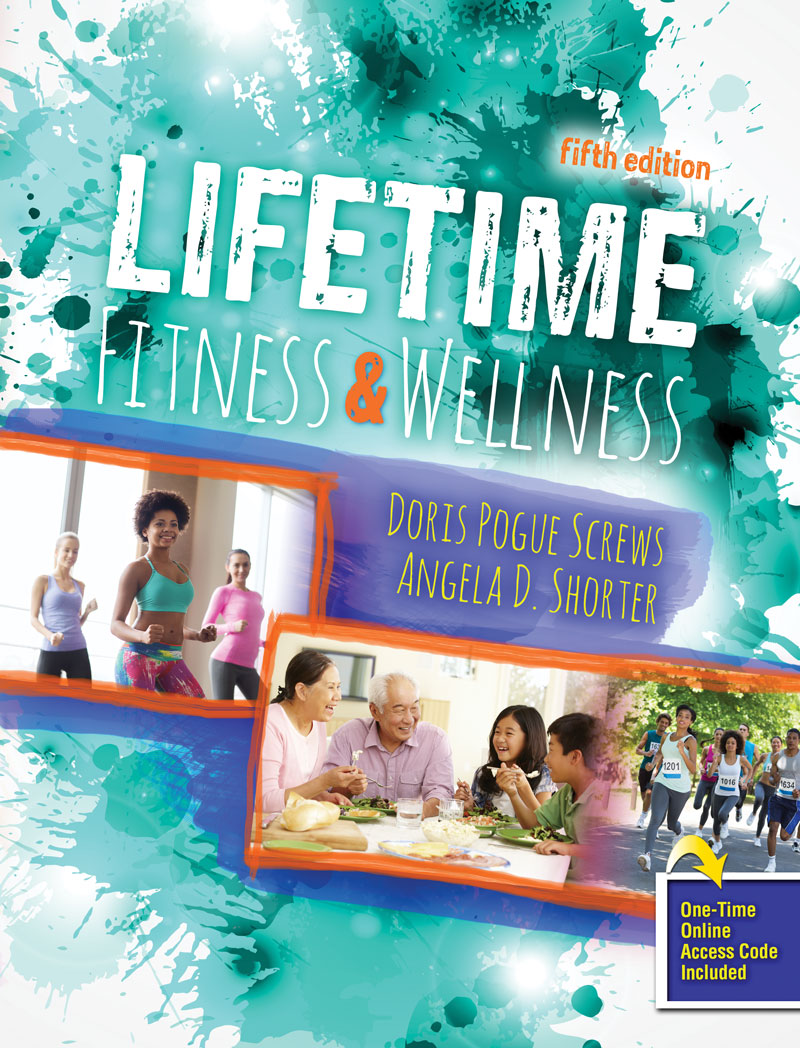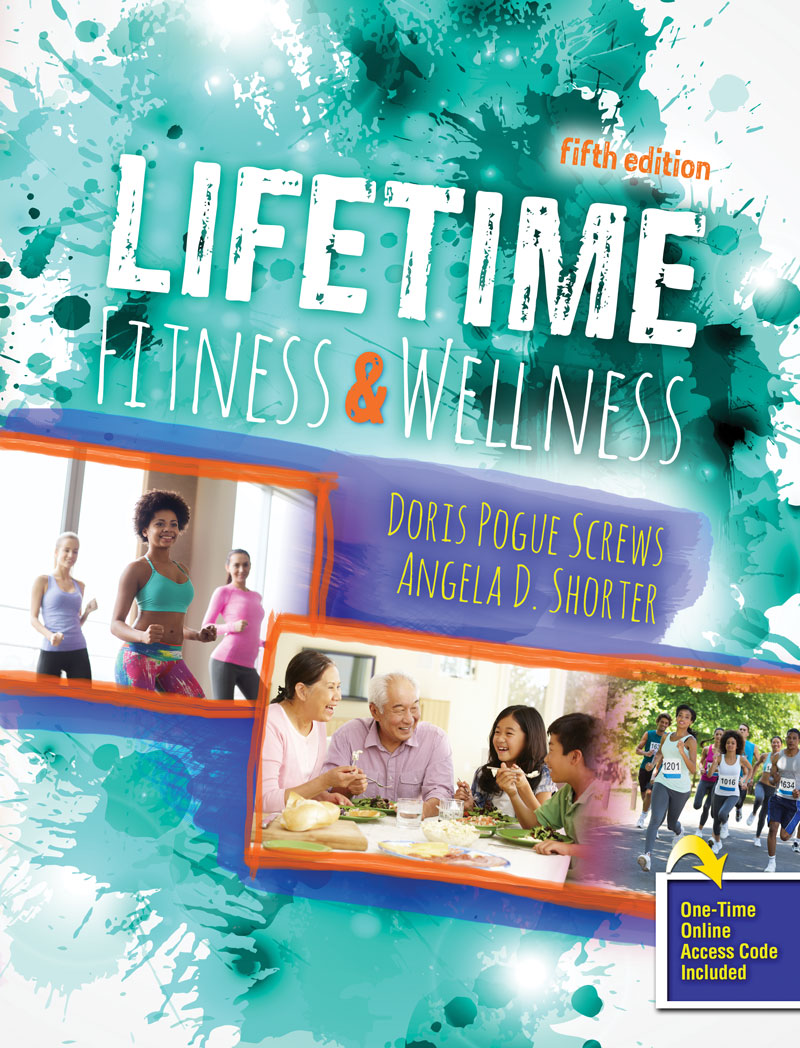This book is designed to help individuals understand how their lives can be enhanced by making and implementing appropriate healthy fitness and wellness choices throughout one’s lifetime. Choices made today will shape your future in all dimensions of wellness. In order to enjoy the highest quality of life, combat degenerative diseases, and cope effectively with day-to-day stressors, a commitment must be made to implement and consistently practice positive fitness and wellness behaviors.
The fifth edition of Lifetime Fitness and Wellness has been revised and updated to provide practical and relevant content for today’s college student and the adult population in general. It is organized into twelve chapters written in a straightforward reader friendly style. Chapter 1 introduces the concepts of health, wellness, and fitness and how they impact longevity. Chapter 3 introduces the health-related components of fitness, while Chapters 4, 5, 6 and 8 examine the health-related components in much greater detail. Chapter 6 and 7 explores safety considerations with regard to participation in physical fitness activities. Chapter 2 focuses on nutritional concepts critical to achieving personal fitness and wellness goals. Chapter 9 examines the emotional aspects of wellness and the effects of stressors in our lives. Chapters 10 through 12 respectively, discusses disease prevention and the impact of drug use and abuse related to inappropriate fitness and wellness choices. This text contains a plethora of information to aid the reader in fully taking charge of his/her personal well-being.
Preface
Chapter 1 Getting on the Wellness Track
Objectives
Understanding Health and Wellness
Dimensions of and Wellness
Barriers to Sound Fitness and Wellness
Benefits of Health-Related Fitness and Wellness
Making Behavior Modifications: Stages of Behavior Change
Summary
References
Internet Sources
Lab 1.1: Behavior Modification—Planning for a Healthy Lifestyle Change
Chapter 2 Nutrition for Wellness
Objectives
Introduction
Nutrients for Wellness
The Wellness Diet
The Quest for an Ideal Diet
Nutrition and Physical Activity
Summary
References
Internet Sources
Lab 2.1: Determining Basal Metabolic Rate
Lab 2.2: Determining Estimated Daily Caloric Needs
Lab 2.3: Three-Day Food Plan
Chapter 3 Health-Related Components of Physical Fitness
Objectives
Introduction
Health-Related Components of Physical Fitness
Physical Fitness Training Principles
Designing a Physical Fitness Program
Exercise Precautions
Summary
References
Internet Sources
Lab 3.1: PAR-Q: The Physical Activity Readiness Questionnaire
Lab 3.2: Screening Questionnaire
Lab 3.3: Health-Related Fitness Goals
Chapter 4 Cardiorespiratory Endurance
Objectives
Introduction
Understanding the Cardiorespiratory System
The Energy Systems
The Physiological Benefits of Improved Cardiorespiratory Endurance
Cardiorespiratory Endurance Program Design
Training Principles
Summary
References
Internet Sources
Lab 4.1: Your Resting Heart Rate
Lab 4.2: Target Heart Rate Zone
Lab 4.3: Cardiorespiratory Endurance Program
Chapter 5 Muscular Strength and Endurance
Objectives
Introduction
Skeletal Muscle Structure
Benefits of Resistance Training
Factors Influencing Strength Production
Resistance Training Program Design
Resistance Training Methods
Resistance Training Guidelines and Safety Tips
Upper Body Exercises
Lower Body Exercises
Summary
References
Internet Source
Lab 5.1: Muscular Strength and Endurance Program
Chapter 6 Developing Flexibility
Objectives
Introduction
Benefits of Flexibility
Joint Classifications
Factors Influencing Flexibility
Types of Flexibility Training
Flexibility Guidelines
Stretching Exercises
Stretching Exercises to Avoid
Designing a Flexibility Program
Back Health
Summary
References
Lab 6.1: Flexibility Program
Chapter 7 Fitness-Related Injuries
Objectives
Introduction
Fitness-Injury Prevention—Tips for Exercising Safely
Fitness-Related Injuries
Treating Fitness-Related Injuries
Injuries Caused by Environmental Conditions
Summary
References
Internet Sources
Chapter 8 Body Composition and Weight Control
Objectives
Introduction
Obesity and Overweight
Body Fat Distribution
Body Composition Assessment Techniques
Eating Disorders
Strategies for Successful Weight Control
Summary
References
Internet Sources
Lab 8.1: Calculating Body Mass Index
Lab 8.2: Body Composition Program
Chapter 9 Understanding Emotional Wellness
Objectives
The Mind-Body Connection
Characteristics of Emotionally Well Individuals
Internal Influences Affecting Emotional Wellness
External Factors Affecting Emotional Wellness
Mental Health Continuum
Stress
Stress Management Techniques
Suicide as a Consequence
Coping Strategies
Summary
References
Internet Sources
Lab 9.1: Health and Fitness Activity
Chapter 10 Sexual Wellness
Objectives
Introduction
Sexually Transmitted Infections
The Sexually Transmitted Infection Epidemic and Risk Factors
Sexually Transmitted Infection Risk Factors
Guidelines for Preventing Sexually Transmitted Infections
Summary
References
Internet Sources
Lab 10.1: What Is Your Risk of Contracting a Sexually Transmitted Infection?
Lab 10.2: STI Attitudes
Chapter 11 Drug Use and Abuse
Objectives
Introduction
Drugs and Their Effects
Drugs Commonly Used, Misused, and Abused
Addictive Characteristics
Strategies Used to Overcome an Addiction
Summary
References
Internet Sources
Lab 11.1: A Letter to My Best Friend
Chapter 12 Chronic Diseases
Objectives
Introduction
Cancer
Cardiovascular Diseases
Diabetes Mellitus
Osteoporosis
Summary
References
Internet Sources
Lab 12.1: Assessing Your Risk for Cancer
Lab 12.2: Assessing Your Risk for Osteoporosis
Lab 12.3: Coronary Heart Disease Risk Appraisal
Appendices
Appendix A
Appendix B
This book is designed to help individuals understand how their lives can be enhanced by making and implementing appropriate healthy fitness and wellness choices throughout one’s lifetime. Choices made today will shape your future in all dimensions of wellness. In order to enjoy the highest quality of life, combat degenerative diseases, and cope effectively with day-to-day stressors, a commitment must be made to implement and consistently practice positive fitness and wellness behaviors.
The fifth edition of Lifetime Fitness and Wellness has been revised and updated to provide practical and relevant content for today’s college student and the adult population in general. It is organized into twelve chapters written in a straightforward reader friendly style. Chapter 1 introduces the concepts of health, wellness, and fitness and how they impact longevity. Chapter 3 introduces the health-related components of fitness, while Chapters 4, 5, 6 and 8 examine the health-related components in much greater detail. Chapter 6 and 7 explores safety considerations with regard to participation in physical fitness activities. Chapter 2 focuses on nutritional concepts critical to achieving personal fitness and wellness goals. Chapter 9 examines the emotional aspects of wellness and the effects of stressors in our lives. Chapters 10 through 12 respectively, discusses disease prevention and the impact of drug use and abuse related to inappropriate fitness and wellness choices. This text contains a plethora of information to aid the reader in fully taking charge of his/her personal well-being.
Preface
Chapter 1 Getting on the Wellness Track
Objectives
Understanding Health and Wellness
Dimensions of and Wellness
Barriers to Sound Fitness and Wellness
Benefits of Health-Related Fitness and Wellness
Making Behavior Modifications: Stages of Behavior Change
Summary
References
Internet Sources
Lab 1.1: Behavior Modification—Planning for a Healthy Lifestyle Change
Chapter 2 Nutrition for Wellness
Objectives
Introduction
Nutrients for Wellness
The Wellness Diet
The Quest for an Ideal Diet
Nutrition and Physical Activity
Summary
References
Internet Sources
Lab 2.1: Determining Basal Metabolic Rate
Lab 2.2: Determining Estimated Daily Caloric Needs
Lab 2.3: Three-Day Food Plan
Chapter 3 Health-Related Components of Physical Fitness
Objectives
Introduction
Health-Related Components of Physical Fitness
Physical Fitness Training Principles
Designing a Physical Fitness Program
Exercise Precautions
Summary
References
Internet Sources
Lab 3.1: PAR-Q: The Physical Activity Readiness Questionnaire
Lab 3.2: Screening Questionnaire
Lab 3.3: Health-Related Fitness Goals
Chapter 4 Cardiorespiratory Endurance
Objectives
Introduction
Understanding the Cardiorespiratory System
The Energy Systems
The Physiological Benefits of Improved Cardiorespiratory Endurance
Cardiorespiratory Endurance Program Design
Training Principles
Summary
References
Internet Sources
Lab 4.1: Your Resting Heart Rate
Lab 4.2: Target Heart Rate Zone
Lab 4.3: Cardiorespiratory Endurance Program
Chapter 5 Muscular Strength and Endurance
Objectives
Introduction
Skeletal Muscle Structure
Benefits of Resistance Training
Factors Influencing Strength Production
Resistance Training Program Design
Resistance Training Methods
Resistance Training Guidelines and Safety Tips
Upper Body Exercises
Lower Body Exercises
Summary
References
Internet Source
Lab 5.1: Muscular Strength and Endurance Program
Chapter 6 Developing Flexibility
Objectives
Introduction
Benefits of Flexibility
Joint Classifications
Factors Influencing Flexibility
Types of Flexibility Training
Flexibility Guidelines
Stretching Exercises
Stretching Exercises to Avoid
Designing a Flexibility Program
Back Health
Summary
References
Lab 6.1: Flexibility Program
Chapter 7 Fitness-Related Injuries
Objectives
Introduction
Fitness-Injury Prevention—Tips for Exercising Safely
Fitness-Related Injuries
Treating Fitness-Related Injuries
Injuries Caused by Environmental Conditions
Summary
References
Internet Sources
Chapter 8 Body Composition and Weight Control
Objectives
Introduction
Obesity and Overweight
Body Fat Distribution
Body Composition Assessment Techniques
Eating Disorders
Strategies for Successful Weight Control
Summary
References
Internet Sources
Lab 8.1: Calculating Body Mass Index
Lab 8.2: Body Composition Program
Chapter 9 Understanding Emotional Wellness
Objectives
The Mind-Body Connection
Characteristics of Emotionally Well Individuals
Internal Influences Affecting Emotional Wellness
External Factors Affecting Emotional Wellness
Mental Health Continuum
Stress
Stress Management Techniques
Suicide as a Consequence
Coping Strategies
Summary
References
Internet Sources
Lab 9.1: Health and Fitness Activity
Chapter 10 Sexual Wellness
Objectives
Introduction
Sexually Transmitted Infections
The Sexually Transmitted Infection Epidemic and Risk Factors
Sexually Transmitted Infection Risk Factors
Guidelines for Preventing Sexually Transmitted Infections
Summary
References
Internet Sources
Lab 10.1: What Is Your Risk of Contracting a Sexually Transmitted Infection?
Lab 10.2: STI Attitudes
Chapter 11 Drug Use and Abuse
Objectives
Introduction
Drugs and Their Effects
Drugs Commonly Used, Misused, and Abused
Addictive Characteristics
Strategies Used to Overcome an Addiction
Summary
References
Internet Sources
Lab 11.1: A Letter to My Best Friend
Chapter 12 Chronic Diseases
Objectives
Introduction
Cancer
Cardiovascular Diseases
Diabetes Mellitus
Osteoporosis
Summary
References
Internet Sources
Lab 12.1: Assessing Your Risk for Cancer
Lab 12.2: Assessing Your Risk for Osteoporosis
Lab 12.3: Coronary Heart Disease Risk Appraisal
Appendices
Appendix A
Appendix B



